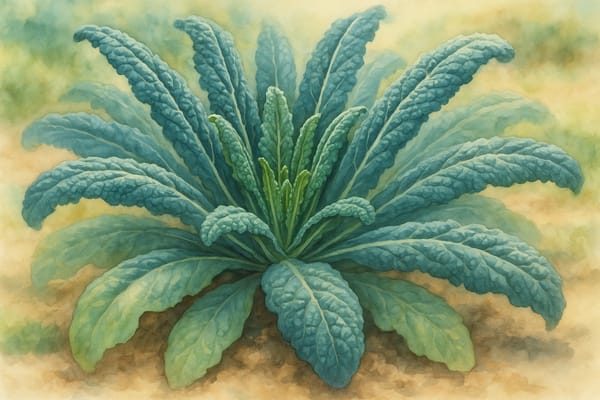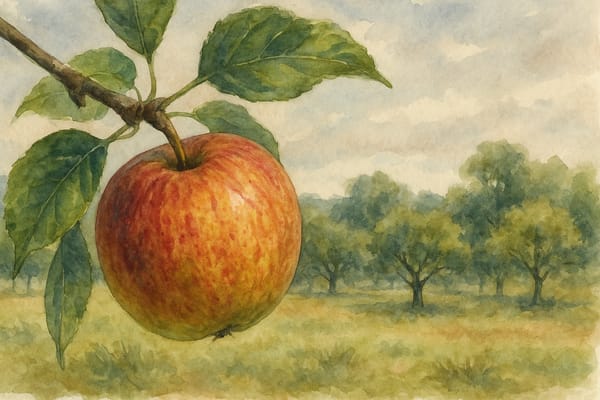In the low-angled light of late autumn, when most garden beds begin to retreat into sleep, a dusky green silhouette stands tall and proud — defiant against the wind, delicious in the cold. Borecole Nero Di Toscana, or Tuscan kale, is no ordinary brassica. With its strappy, savoyed leaves that deepen in colour with each passing frost, it belongs not just in the kitchen garden, but in the tapestry of any winter-ready plot that seeks both beauty and nourishment.
Sometimes known as Cavolo Nero or Dinosaur Kale, this heirloom variety has deep roots in Italian tradition, where it forms the backbone of ribollita and other peasant soups. But here in Cornwall, where the salty wind and fickle seasons keep gardeners guessing, it proves just as worthy. Hardy, handsome, and enduring, Nero Di Toscana is as much a gardener’s ally as it is a cook’s delight.
Sowing with Intention
Start it early if you like: from February indoors in trays, or from April onwards directly into the ground. Its seed is forgiving, germinating reliably within 5 to 10 days when soil or module temperatures hover between 13–24°C. Sow 1–1.5cm deep, either thinly in rows or singly in modules. Once seedlings are 5–10cm tall and sporting a few true leaves, it’s time to find them a more permanent home.
Site and Soil
Nero Di Toscana appreciates a well-prepared bed. Think fertile, moisture-retentive soil, rich in compost or well-rotted manure. The pH sweet spot lies between 6.0 and 7.0 — lime if needed, especially if club root has ever haunted your brassica patch. Full sun is best, though it will tolerate a bit of shade. Avoid waterlogging; if in doubt, a raised bed or ridge planting will lift its feet out of harm’s way.
Space to Breathe
This is a kale that likes to stretch. Mature plants benefit from 45–60cm spacing in all directions. That generous room isn’t indulgence — it’s airflow, light, and easier harvesting. The leaves unfurl with drama and texture, and crowding only invites mildew and competition. If you’re sowing densely for baby leaves, a 10cm spacing will do, but give your cooking kale the space it deserves.
Watering, Feeding & Growing On
Water steadily while young, especially just after planting out, but once established, Nero Di Toscana is fairly drought-resilient. A mulch of compost or leaf mould will lock in moisture and feed the roots slowly. In rich soil, extra feeding isn't necessary. In containers or leaner plots, a nitrogen-rich organic fertiliser every month or so keeps leaves coming.
As summer wanes and the harvest begins, resist the urge to strip too many leaves at once. Always harvest from the bottom, preserving the crown for new growth. The cut-and-come-again habit is one of this plant's gifts.
When the Frost Comes
Herein lies one of Nero Di Toscana’s most enchanting traits: it improves with hardship. Frost triggers the conversion of starches into sugars, deepening flavour and softening any bitterness. Picked after a hard freeze, the leaves are not only sweeter, but also more textured and complex. The plant shrugs off temperatures that send others into retreat, offering harvests deep into winter, even into early spring.
Troubles and Triumphs
Like all brassicas, Nero Di Toscana has its enemies. Cabbage whites will seek it out, so fine netting is advised, particularly when young. Slugs may nip at seedlings; deter with barriers or hand-picking. Club root can be avoided with good rotation and neutral soil. Above all, vigilance pays off: check under leaves, remove yellowing growth, and allow the plant to breathe.
In wind-prone areas, a tall kale may need support. A single stake and a soft tie will do. In harsher winters, earth up around the base and consider fleece. But even exposed, this kale holds its ground.
The Winter Kitchen
Beyond the garden, Nero Di Toscana brings its drama to the plate. Deep green ribbons in soups and stews, a simple steam and olive oil finish, or tossed with garlic and chilli over pasta. With every harvest, the plant gives you both flavour and heritage.
A Garden Essential
For anyone looking to extend the productivity of their plot into the dark days, Borecole Nero Di Toscana is essential. It lends texture to borders, tenacity to your winter larder, and a sense of continuity in a season when most things fade. Plant it not just for its use, but for its presence. Let it be a companion through storms and slow, cold mornings. The rewards will keep coming.
And once you grow it, you’ll likely never want a winter without it again.











